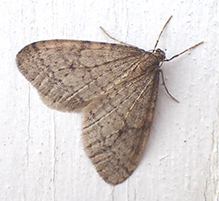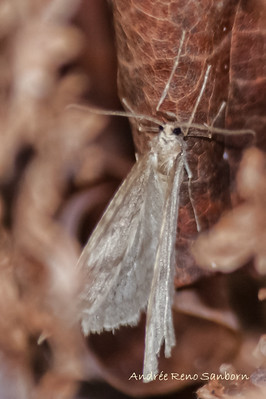Bruce spanworm moth
(Operophtera bruceata)
Conservation • Description • Habitat • Ecology • Distribution • Taxonomy
|
||||||||
| Hodges # | 7437 |
|||||||
Conservation Status |
||||||||
| IUCN Red List | not listed |
|||||||
| NatureServe | NNR - Unranked SNR - Unranked |
|||||||
| Minnesota | not listed |
|||||||
Description |
||
Bruce spanworm moth is a medium-sized, late season, carpet moth. It occurs in the United States in the east from Maine to northern virginia, west to North Dakota and eastern Kansas. It also occurs in the Pacific Northwest, in Colorado, in Alaska, and across southern Canada. Adults are found from October to December in deciduous woodlands. The larvae feed on young, nearly unfurled leaves of hardwood trees and shrubs, mostly on sugar maple, American beech, and quaking aspen, but also on birch, cherry, elm, hazelnut, maple, oak, serviceberry, willow, and witch hazel. It is considered a pest of blueberry and of apple and cherry trees. During outbreaks, the larvae may enshroud an entire tree with a silky web. Adult males have a 1″ to 1 3⁄16″ (25 to 30 mm) wingspan. The forewing length is ½″ to 11⁄16″ (12 to 18 mm). The abdomen is brown to golden brown. The forewings are broad and rounded at the tip. The ground color is variable, pale brown east of the Rocky Mountains, pale gray west of the Rocky Mountains. The antemedial (AM), median, postmedial (PM), and subterminal (ST) lines are narrow, deeply scalloped, and usually faint, but they are sharply defined. The AM and PM lines are doubled and are often filled with brown shading. The terminal line is represented by a row of single black spots. The discal spot is black and small but distinct. The forewing accessory cell is elongate, extending far beyond the discal cell. vein M1 begins far from the origin of veins R4 and R5. The hindwing is somewhat paler. The median, PM, ST, and terminal lines are usually present. Female wings are rudimentary, greatly reduced, or entirely missing. They do not fly. Caterpillars are plump and about ¾″ (2 cm) long. They are usually pale glossy green, but during outbreaks they may be grayish-green, smoky, brown, or black. On the upper side there is a widely spaced pair of whitish stripes. The breathing pores (spiracles) on the sides of each abdominal segment are yellowish-orange. There is a weak, mostly broken stripe above the spiracles, and a faint, mostly broken stripe below the spiracles. Scattered short hairs (setae) rise from whitish bases. There are only two pairs of abdominal legs (prolegs). |
||
Size |
||
Wingspan: 1″ to 1 3⁄16″ (25 to 30 mm) |
||
Similar Species |
||
Habitat |
||
Deciduous woodlands |
||
Ecology |
||
Season |
||
October to December |
||
Behavior |
||
Adult males are active at night and will come to lights. |
||
Life Cycle |
||
The female lays eggs in crevices in bark. The eggs overwinter. Mature caterpillars are active from May to June. |
||
Larva Hosts |
||
Leaves of hardwood trees and shrubs including sugar maple, American beech, quaking aspen, birch, cherry, elm, hazelnut, oak, serviceberry, willow, and witch hazel. |
||
Adult Food |
||
|
||
Distribution |
||||
|
Sources |
|||
| 10/16/2023 | ||||
Occurrence |
||||
Common |
||||
Taxonomy |
|||
Order |
Lepidoptera (Butterflies and Moths) | ||
Superfamily |
Geometroidea (Geometrid and Swallowtail Moths) | ||
Family |
Geometridae (Geometer Moths) | ||
Subfamily |
Larentiinae (carpet moths) | ||
Tribe |
Operophterini | ||
Genus |
Operophtera | ||
Subordinate Taxa |
|||
A revision of the genus Operophtera (Troubridge and Fitzpatrick, 1993) proposed submerging western Bruce spanworm (Operophtera occidentalis) as a subspecies of Operophtera bruceata. The proposal was not widely accepted. |
|||
Synonyms |
|||
Cheimatobia bruceata Operophtera groenlandica Rachela bruceata |
|||
Common Names |
|||
Bruce spanworm moth |
|||
Glossary
Proleg
A fleshy structure on the abdomen of some insect larvae that functions as a leg, but lacks the five segments of a true insect leg.
Spiracle
A small opening on the surface of an insect or arachnid through which it breathes.
Seta
A stiff, hair-like process on the outer surface of an organism. In Lepidoptera: A usually rigid bristle- or hair-like outgrowth used to sense touch. In mosses: The stalk supporting a spore-bearing capsule and supplying it with nutrients. Plural: setae. Adjective: setose.
Visitor Photos |
|||||
Share your photo of this insect. |
|||||
| This button not working for you? Simply email us at info@MinnesotaSeasons.com. Attach one or more photos and, if you like, a caption. |
|||||
Babette Kis |
|||||
Operophtera bruceata, Bruce spanworm moth Operophtera bruceata, Bruce spanworm moth on door frame of house adjacent to Barnes Prairie, Racine Co., WI. Photographed November 7, 2020. … it's very commonly seen here in fall through winter. |
 |
||||
MinnesotaSeasons.com Photos |
|||||
|
|||||

Visitor Videos |
|||
Share your video of this insect. |
|||
| This button not working for you? Simply email us at info@MinnesotaSeasons.com. Attach a video, a YouTube link, or a cloud storage link. |
|||
Other Videos |
|||
| Bruce Spanworm Moth (Geometridae: Operophtera bruceata) Male Carl Barrentine |
|||
About
Oct 15, 2011 Photographed at Grand Forks, North Dakota (14 October 2011). Thank you to Nina (@Bugguide.net) for confirming the identity of this specimen! |
|||
| Bruce Spanworm Moth (Geometridae: Operophtera bruceata?) on Wall Carl Barrentine |
|||
About
ov 5, 2010 Photographed near Fisher, Minnesota (31 October 2010). Thank you to Peter Edelman (@Bugguide.net) for identifying this specimen! |
|||
| Operophtera bruceata - Bruce Spanworm Moth Les Leighton |
|||
About
Nov 5, 2012 Family Geometridae / Subfamily Larentiinae . This is a Winter Moth known as the Bruce Spanworm Moth ( Operophtera bruceata ) Seen at Forest Grove Park, Burnaby, BC September 5, 2012 |
|||


Created: 10/16/2023
Last Updated:



